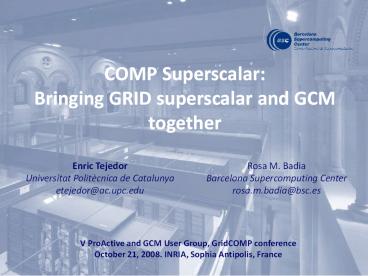COMP Superscalar: Bringing GRID superscalar and GCM together PowerPoint PPT Presentation
Title: COMP Superscalar: Bringing GRID superscalar and GCM together
1
COMP Superscalar Bringing GRID superscalar and
GCM together
Enric Tejedor Universitat Politècnica de
Catalunya etejedor_at_ac.upc.edu
Rosa M. Badia Barcelona Supercomputing
Center rosa.m.badia_at_bsc.es
V ProActive and GCM User Group, GridCOMP
conference October 21, 2008. INRIA, Sophia
Antipolis, France
2
Outline
- Introduction
- Grid Component Model
- GRID superscalar
- Programming model
- Runtime operation
- Initialisation
- Task processing
- Finalisation and error handling
- Conclusions
3
1. Introduction
4
Basic concepts
- The Grid Component Model (GCM)
- CoreGRID NoE, GridCOMP
- Distributed, based on Fractal, intended for the
Grid - GRID superscalar
- Framework to ease the development of Grid-unaware
applications - Simple programming model Grid as transparent as
possible - Runtime that optimises the performance of the
application (exploiting possible concurrency)
5
A componentised Grid framework
- GRID superscalar is suitable to benefit from the
GCM features - Componentisation process identify the inner
functionalities of the runtime, and assign each
one to a separate component - Result COMP Superscalar, whose runtime gains in
- Reusability
- Flexibility
- Deployability
- Separation of concerns
- Ease of development
6
Componentised runtime
7
2. Programming model
8
Programming model
Parallel Resources (multicore,SMP, cluster, grid)?
Synchronization, results transfer
Resource 1
Resource 2
Task selection parameters direction (input,
output, inout)?
Sequential Application
Resource 3
... for (i0 iltN i) T1 (data1, data2)
T2 (data4, data5) T3 (data2, data5, data6)
T4 (data7, data8) T5 (data6, data8,
data9) ...
. . .
Resource N
Scheduling, data transfer, task execution
Task graph creation based on data precedence
9
COMPSs programming model
initialize(f1) for (int i 0 i lt 2 i)
genRandom(f2) add(f1, f2) print(f2)
Java application
Java interface
- public interface SumItf
- _at_ClassName(example.Sum")
- _at_MethodConstraints(OSType "Linux")
- void genRandom(
- _at_ParamMetadata(type Type.FILE, direction
Direction.OUT) - String f
- )
- _at_ClassName(example.Sum")
- ...
Implementation
Task constraints
Parameter metadata
10
Usage example original code
- initialize(f1)
- for (int i 0 i lt 2 i)
- genRandom(f2)
- add(f1, f2)
- print(f1)
11
PM steps (1) selecting the tasks
- public interface SumItf
- _at_ClassName(example.Sum")
- _at_MethodConstraints(OSType "Linux")
- void genRandom(
- _at_ParamMetadata(type Type.FILE, direction
Direction.OUT) - String f
- )
- _at_ClassName(example.Sum")
- _at_MethodConstraints(processorArch "Intel",
processorSpeed 1.8f) - void add(
- _at_ParamMetadata(type Type.FILE, direction
Direction.INOUT) - String f1,
- _at_ParamMetadata(type Type.FILE, direction
Direction.IN) - String f2
- )
Implementation
Task constraints
Parameter metadata
12
PM steps (2a) using API calls
- initialize(f1)
- COMPSs css new COMPSsImpl()
- css.start()
- for (int i 0 i lt 2 i)
- genRandom(f2)
- add(f1, f2)
- String resF2 css.openFile(f2, OpenMode.READ)
- print(resF2)
- css.stop(true)
13
PM steps(2b) no changes!
- initialize(f1)
- for (int i 0 i lt 2 i)
- genRandom(f2)
- add(f1, f2)
- print(f1)
14
Custom Java Class Loader
15
3. Runtime operation
16
Implementation details
- Base technologies
- Java as programming language
- ProActive implementation of the GCM model, used
to build the components - JavaGAT used for job submission and file transfer
17
Initialization
- Multicast invocation
- Forwarded to all subcomponents
JM
TA
TS
init()
FM
FIP
FTM
18
Initialization
- Multicast invocation
- Reduction of return values
JM
TA
TS
Reduction
FM
Reduction
FIP
FTM
19
Task processing (1)
- Application submits task
- Task Analyser receives the request
TA
TS
JM
executeTask()
FM
FIP
FTM
20
Task processing (2)
- File Information Provider is contacted
- File accesses of the task are registered
JM
TA
TS
executeTask()
FM
FIP
FTM
21
Task processing (3)
- Task Analyser discovers dependencies
- Dependency-free tasks are sent for scheduling
TA
TS
JM
executeTask()
FM
FIP
FTM
22
Task processing (4)
- Task Scheduler decides where to execute tasks
- Job Manager is informed of this decision
Resource capabilities
Task constraints
TS
JM
TA
Scheduling algorithm
executeTask()
FM
FIP
FTM
23
Task processing (5)
- Job Manager checks the necessary file transfers
- File Transfer Manager actually performs them
TA
TS
JM
executeTask()
FM
GAT
FIP
FTM
24
Task processing (6)
- FTM informs of the end of transfers for a task
- Task Grid job, submitted for execution
GAT
TA
TS
JM
executeTask()
FM
FIP
FTM
25
Task processing (7)
- Callback for the end of a job is received
- The notification is forwarded to the Task Analyser
GAT
TA
TS
JM
executeTask()
FM
FIP
FTM
26
Opening a file
- Java Application
- String ren openFile(f)
- print(ren)
A P I
JM
TS
TA
FM
FIP
FTM
Local host
Remote host
f10v6.IT
f10v6.IT
27
Error handling
- The COMPSs runtime could experience errors of
different kinds (e.g. a job submission failure) - Default response to an error stopping the
components - But a structure of components cannot be stopped
in any arbitrary order!
stopFc on B is never served!
stopFc()
LCC
A
C
B
28
Safe stopping process for the runtime
- COMPSs subcomponents have data dependencies
- Modification of the Life Cycle Controller
- Components stopped in a safe order TS, TA, JM,
FTM, FIP - Otherwise, a deadlock could happen
LCC
TA
TA
TS
JM
FM
FIP
FTM
29
4. Conclusions
30
Conclusions
- COMP Superscalar componentised version of GRID
superscalar - GCM-based
- Hierarchical runtime separation of concerns
- Task scheduling, file and resource management
- Straightforward programming model for
Grid-unaware Java applications - Feedback about GCM-ProActive
- Component distribution
- Performance no noticeable overhead for a medium
number of tasks - Component composition and dynamic
reconfiguration Grid IDE
31
Thank you!Questions?

